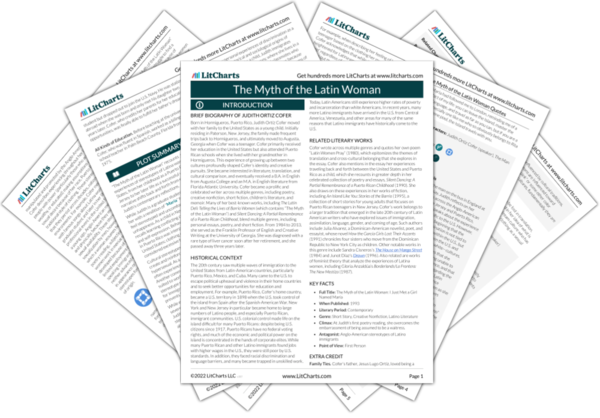Cofer articulates a central tension in the lives of Latina women in the Anglo-American world: namely, that being accepted into Anglo-American culture often forces them to disavow or abandon the cultural heritage and traditions of their native countries. For example, Cofer describes how, as a child and teenager, the Puerto Rican mothers she knew dressed their daughters in clothes that were excessively formal, mature, or ornamental by American standards. Cofer recalls wanting to dress like a conventional American girl after feeling left out at a birthday party because her dress did not allow her to play with the other children. She was also once treated as unprofessional at a high school Career Day event because her clothing and jewelry were considered too festive. As Cofer gains more professional success and, accordingly, becomes increasingly accepted within mainstream American society, she struggles to navigate the expectation of conformity to the culture. To that end, when she experiences harassment, she feels pressured to perform a certain kind of Anglo-American control of her emotions, worrying that she might confirm the stereotype of the fiery Latina woman if she were to respond to her own mistreatment with anger. However, Cofer’s professional success—which she garners by writing poetry and fiction about Latina women and her Puerto Rican heritage—also allows her to retain a strong connection to her cultural identity. In turn, “The Myth of the Latin Woman” depicts how, though Latina women often struggle to find a sense of belonging in Anglo-American society because of stereotypes and marginalization, it is possible for Latina women to preserve their cultural identity while carving out a place for themselves within mainstream culture.
Belonging, Assimilation, and Cultural Heritage ThemeTracker

Belonging, Assimilation, and Cultural Heritage Quotes in The Myth of the Latin Woman
Maria had followed me to London, reminding me of a prime fact of my life: you can leave the Island, master the English language, and travel as far as you can, but if you are a Latina, especially one like me who so obviously belongs to Rita Moreno’s gene pool, the Island travels with you.
But it was painfully obvious to me that to the others, in their tailored skirts and silk blouses, we must have seemed “hopeless” and “vulgar.”
[T]o him, I was just an Evita or a María: merely a character in his cartoon-populated universe.
Since I do not wear my diplomas around my neck for all to see, I too have on occasion been sent to that “kitchen,” where some think I obviously belong.
Every time I give a reading, I hope the stories I tell, the dreams and fears I examine in my work, can achieve some universal truth which will get my audience past the particulars of my skin color, my accent, or my clothes.
[This poem] is a prayer for communication, and for respect. In it, Latin women pray “in Spanish to an Anglo God / with a Jewish heritage,” and they are “fervently hoping / that if not omnipotent, / at least He be bilingual.”











